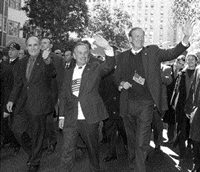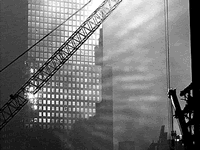Annual Report 2002
The Industry Responds
The New York City construction industry has served as a shining example of this City’s strength, character and innovation in the aftermath of September 11. The efforts of those at Ground Zero have surpassed all expectations in terms of speed, safety and coordination. Rapid progress has been achieved while at the same time accomplishing the overarching goal to preserve human dignity and prepare for the rebuilding process.
Sense of Duty
The men and women of the construction industry are first and foremost New Yorkers, and their response in the minutes, hours, days and months after the attack personified the spirit of the City. To a person, they went to the site, not looking for any glory, but just wanting to do whatever they could to help.
 The industry’s initial response to the attack came within minutes as skilled members of the building trades dropped their equipment at various worksites throughout the City and rushed to Lower Manhattan to provide the help they knew would be needed. They were quickly followed by a host of architects and engineers and contractors who risked their lives inspecting the damage, assessing structures, moving in heavy equipment and advising emergency personnel. These early responders, individuals and firms, remained for days and weeks, and many, including those tapped by the Federal Emergency Management Agency (FEMA), agreed to work for months on nothing more than a handshake. The companies remained even when it became apparent that insurance protection was not immediately forthcoming. In short, they risked their livelihoods to help the victims, their City, and their nation.
The industry’s initial response to the attack came within minutes as skilled members of the building trades dropped their equipment at various worksites throughout the City and rushed to Lower Manhattan to provide the help they knew would be needed. They were quickly followed by a host of architects and engineers and contractors who risked their lives inspecting the damage, assessing structures, moving in heavy equipment and advising emergency personnel. These early responders, individuals and firms, remained for days and weeks, and many, including those tapped by the Federal Emergency Management Agency (FEMA), agreed to work for months on nothing more than a handshake. The companies remained even when it became apparent that insurance protection was not immediately forthcoming. In short, they risked their livelihoods to help the victims, their City, and their nation.
 Spirit of Collaboration
Spirit of Collaboration
Perhaps no aspect of the overall effort at Ground Zero has been more remarkable than the unprecedented spirit of support and cooperation. From the police, fire and federal emergency personnel to the laborers, engineers, architects and contractors, everyone seemed to feel a sense of interdependence and mutual respect as the work progressed. As they moved from day to day, these once perfect strangers began to form closer working relationships predicated on teamwork and shared objectives.
Thanks in large part to the 24/7 efforts of the New York City Department of Design & Construction (DDC), which spearheaded the entire effort, the work quickly moved from the chaos of the first few days to a smoothly-operating worksite with clear lines of authority and responsibility. Within the construction industry, individual contractors and subcontractors, whose prior relationships had been based on spirited competition, were constant and committed collaborators, all the while working closely with skilled trades to ensure the work progressed efficiently.
 Rapid Cleanup
Rapid Cleanup
Accurately assessing the overwhelming destruction was impossible given that such an attack was without precedent. Still, every expert in the field predicted that the rescue and clean-up would take a minimum of a year and probably 18 months. The thought that it could take less than eight months seemed impossible. But thanks to DDC’s coordination, the unprecedented cooperation, and the steadfast devotion of the City’s skilled trades, the work far outpaced even the wildest expectations.
In doing so, the industry recovered victims sooner and helped grieving families and loved ones more quickly start the healing process. They helped the City as well as the nation begin to put this sad chapter of devastation behind them. And most importantly, they paved the way for the area’s rapid revitalization, which ultimately sends a message to the world that New York remains strong and dedicated to a fast and magnificent rebuilding.
 Focus on Safety
Focus on Safety
Ground Zero may be the most dangerous construction site in New York City history. Danger lurked at every step as workers dealt with a debris field that was at best random. Large portions of flooring or a pile of rubble could be in place one instant, only to suddenly collapse the next. Only the most experienced hands could comprehend the vast maze of tunnels, concourses, retaining walls, ramps and water buried under the tons of rubble.
Given the way New York’s construction industry handles safety at all of its construction sites, many watchers were relieved, but not necessarily amazed, that such a massive operation should be completed without a single major injury. No City in the world is more adept at protecting its workers from the perils of urban construction than New York. Perhaps no other City could have responded as well to such an horrific attack.
Institutional knowledge also played a vital role as industry veterans, involved in the design and construction of the World Trade Center complex three decades ago, served as guides and protectors of emergency and construction workers. By using their knowledge of the site – above and below ground – they helped all personnel anticipate and avoid danger at every step of the rescue and recovery process.
 Our Finest Hour?
Our Finest Hour?
The construction industry’s immediate and sustained response to the senseless destruction of September 11 exemplifies all that is good about the industry and the City in which it operates. For perhaps the first time, all of the industry’s talent, dedication, resourcefulness and determination have been on display for the people of New York, the United States and the world to see.
Many in the industry believe that, thanks to the attention paid to efforts at Ground Zero, the industry is being portrayed in a truly accurate and comprehensible manner for the first time in memory. In that respect, the industry shines as never before. But in some eyes, New York’s skilled labor, contractors, subcontractors, architects and engineers were merely doing what they do, with less fanfare, every day at sites throughout the City. Still others see the finest hour as yet to come – when the City asks the industry to turn their ideas for a new Lower Manhattan into reality.
Looking Forward
The spirit of collaboration among the industry’s diverse segments and the newfound respect for its work among the general public bodes well for the future of this City. The challenges facing the industry figure not only to continue but perhaps even to grow as the focus shifts from rescue, recovery and clean-up to the rebuilding and revitalization effort. No matter what is decided upon in terms of a fitting memorial, an intermodaltransportation hub, a technologically superior power/telecommunications network and a mixed-use development, the building community stands ready to make those plans reality.



